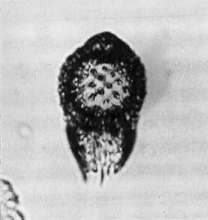 Carpocanopsis
cristata (Carnevale)
Carpocanopsis
cristata (Carnevale) Carpocanopsis
cristata (Carnevale)
Carpocanopsis
cristata (Carnevale)? Sethocorys cristata Carnevale, 1908, p.31, pl.4, fig.18
? Sethocorys cristata var. a Carnevale, 1908, p.32, pl.4, fig.19
Carpocanopsis cristatum (Carnevale) ?, Riedel and Sanfilippo, 1971, p.1597, pl.1G, fig.16, pl.2G, figs.1-7
Carpocanopsis cristata (Carnevale) ?, Sanfilippo and Riedel, 1973, p.531
Cephalis hemispherical, in rare specimens bearing a short apical spine, usually separated from the thorax by a change in external contour. Thorax inflated barrel-shaped, with very thick wall and rough surface, and with fewer pores than C. cingulata and C. bramlettei, not longitudinally aligned. Abdomen usually represented by only a few corroded protuberances on the distal part of the thorax, but to judge from portions preserved on rare specimens it appears not to be separated from the thorax by an externally expressed stricture, and to have irregular pores similar to those of C. cingulata (Riedel and Sanfilippo, 1971).
Dimensions and other features are generally similar to those given by Carnevale for specimens from the Italian Miocene, but we cannot be confident of the identity of our species with his until there is an opportunity to examine additional Italian material (Riedel and Sanfilippo, 1971).
The dimensions given for Sethocorys cristata in Carnevale (1908) are as follows: Height of cephalis 24 mm, height of thorax 73 mm. Maximum breadth 98 mm. Length of horn 9 mm. Breadth of distal opening 34 mm. Length of "abdomen" 9 mm.
The dimensions given for Sethocorys cristata var. a in Carnevale (1908) are as follows: Height of cephalis 24 mm, height of thorax 78 mm. Maximum breadth 98 mm. Breadth of cephalis 39 mm. Breadth of distal opening 31 mm. Length of "abdomen" 9 mm. Length of thorns 9 mm.
This species is distinguished from C. favosa by the abdomen being porous rather than hyaline, and evidently inverted truncate-conical (narrowing distally). It differs from C. cingulata [in having fewer pores, not longitudinally aligned, on the thorax, and a rough surface.] (Riedel and Sanfilippo, 1971).
This low-latitude species has its morphotypic first appearance in the Calocycletta costata Zone and its morphotypic last appearance in the Diartus petterssoni Zone.